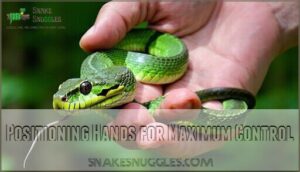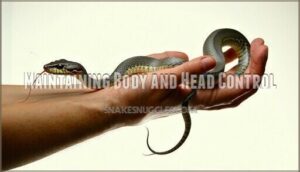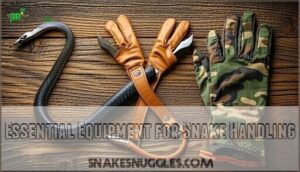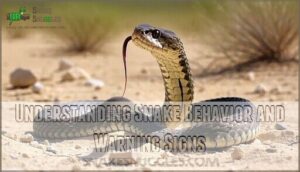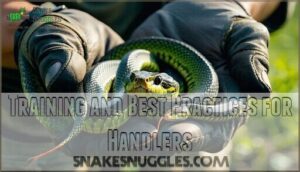This site is supported by our readers. We may earn a commission, at no cost to you, if you purchase through links.

If your heartbeat skips when you reach for slick scales, you’re not alone. Knowing how to hold a venomous snake and not get bitten isn’t about luck or superstition. It’s skill—earned, practiced, then repeated until every movement feels second nature.
Table Of Contents
- Key Takeaways
- Safe Techniques for Holding Venomous Snakes
- Essential Equipment for Snake Handling
- Understanding Snake Behavior and Warning Signs
- Risks, Consequences, and Emergency Protocols
- Training and Best Practices for Handlers
- Frequently Asked Questions (FAQs)
- What are the potential risks and dangers of holding a venomous snake?
- How can one ensure their own safety while holding a venomous snake?
- What are some common mistakes to avoid when handling venomous snakes?
- How do you safely transport a venomous snake?
- What should you do if a snake escapes?
- How do you clean and disinfect after handling?
- Can you work with venomous snakes alone?
- What are common myths about venomous snake handling?
- Conclusion
Key Takeaways
- Always approach and secure a venomous snake with calm, practiced movements and proper hand placement to maintain full control and minimize risk.
- Use specialized equipment like hooks, tongs, gloves, and protective clothing to keep distance and reduce chances of a bite, but never assume gear offers absolute protection.
- Recognize and respect a snake’s warning signs—such as coiling, hissing, or striking posture—to avoid provoking aggressive or defensive reactions.
- If bitten, act immediately by immobilizing the limb, seeking medical help, and knowing the snake’s species to ensure the right treatment and increase chances of recovery.
Safe Techniques for Holding Venomous Snakes
Holding a venomous snake isn’t something you can wing—it demands precision, control, and the right approach from start to finish.
The techniques below walk you through each critical step, from how you move toward the animal to how you secure both its head and body. Master these fundamentals, and you’ll greatly reduce your risk of getting bitten.
Approaching The Snake Correctly
When you move too slowly, you give the snake time to track your presence and strike, so professionals approach swiftly from behind to minimize reaction time.
Start with a visual assessment from a safe distance, reading the snake’s behavior for signs of stress or aggression. Keep a calm demeanor throughout, because nervous energy translates into jerky movements that trigger defensive strikes.
Your rear approach should be deliberate and confident, not hesitant.
Positioning Hands for Maximum Control
Once you’re within range, your thumb and forefinger become the two points of control that determine whether you maintain dominance or lose it entirely. Proper hand placement behind the skull requires precise body alignment and controlled movements to prevent the snake from twisting free.
Your grip strength matters, but technique trumps force:
- Position your dominant hand directly behind the head, with your thumb and forefinger targeting the pressure points just behind the jawbone
- Keep your non-dominant hand ready to support the snake’s body, preventing dangerous coiling
- Maintain steady body alignment—leaning too far forward compromises your balance and reaction time
These manipulation techniques for venomous snakes require practiced coordination, because hesitation invites injury.
Pinching Behind The Skull Safely
The pinch itself—that final commitment of thumb and forefinger to skull—is where most animal wranglers either prove their training or end up in an ambulance. You’re targeting pressure point control just behind the jawbone, applying firm but measured grip strength—enough to immobilize the head without crushing delicate bone structures.
Avoid the venom glands positioned slightly behind your contact points. This skull pinch technique demands steady pressure because any wobble gives the snake an opening to twist free or strike. Safe snake animal control techniques require you to commit fully once contact begins.
Maintaining Body and Head Control
Holding the head steady is only half the battle—a venomous snake’s body can whip, coil, and leverage its entire muscular length against your grip if you don’t control it properly. Safe snake control techniques require you to secure the body immediately after head stabilization:
- Support the lower third of the body with your free hand, preventing tail whips that destabilize your secure grip.
- Keep controlled movement by tucking the snake’s midsection against your forearm, minimizing struggle through gentle compression.
- Maintain body positioning that prevents the snake from gaining leverage—never let loops form around your wrist or arm during controlling venomous snakes.
Essential Equipment for Snake Handling
You won’t get far working with venomous snakes with bare hands alone. Professional herpetologists rely on specialized tools—snake hooks, tongs, gloves, and protective clothing—to maintain a safe distance and reduce bite risk.
Here’s what you need to know about each piece of equipment and how to use it properly.
Choosing and Using Snake Hooks and Tongs
Snake hooks and tongs aren’t just fancy accessories—they’re your first line of defense when working with venomous species, keeping critical distance between you and those fangs. A quality snake hook with durable hook material gives you control during relocation, while snake tongs offer greater grip strength for secure capture.
Choose tong length based on the species—longer tongs provide safer distance for larger snakes.
Regular maintenance tips include checking for loose joints and corrosion to make sure your snake equipment stays reliable when it matters most.
Pros and Cons of Snake-Resistant Gloves
When you’re weighing whether to pull on snake-resistant gloves, it’s smart to know what you’re really getting—and what they can’t quite promise.
- Bite resistance is only as good as the glove material and fit.
- Gloves stiffen your grip, so dexterity impact can cost you fine control during snake restraint.
- Glove limitations: sharp fangs and quick movements occasionally defeat even premium snake restraint equipment.
Selecting Protective Clothing
Before you step anywhere near a venomous snake, think carefully about what you’re wearing from head to toe. Heavy boots and thick denim block fangs better than thin cloth, yet no protective clothing guarantees safety—especially with agile species. Glove materials and fit considerations matter, too: even top-tier snake equipment has clothing limitations you need to respect if true snake safety is your aim.
| Protective Gear | What It Really Does |
|---|---|
| Thick Gloves | Deters bites, limits finger movement |
| Denim/Canvas | Slows short fangs, not immune to strikes |
| Leather Boots | Best for ground-dwellers |
| Snug Fit | Fewer gaps for fangs to exploit |
| Layering | Adds resistance, but never complete armor |
Understanding Snake Behavior and Warning Signs
Knowing how a venomous snake thinks gives you a real advantage when it comes to staying safe. Each snake has a way of showing discomfort or warning you off.
Let’s walk through the key signals to watch for so you can approach each situation with confidence.
Recognizing Defensive Postures
Ever seen a snake coil tightly and lift its head, almost like it’s sizing you up for a standoff? That’s classic Defensive Body Language.
Watch for slow, methodical Head Positioning, jittery Tail Movements, or Audible Warnings like hissing or rattling. All these are cues—nature’s yellow light—telling you the snake’s Strike Range is ready, demanding sharp snake behavior awareness in your care techniques.
Identifying Signs of Aggression
Think you know a snake’s mood? Just wait until you see how quickly a flickering tongue or sudden whip of the tail can flip the script from calm to all-out alarm. Watch for:
- Hissing sounds that cut the silence
- Body language turning rigid
- Pupil dilation as threat rises
- Swift strike positioning
- Sudden defensive coiling
Reducing Stress for The Snake
Easing a snake’s nerves is a bit like fine-tuning a radio—you need just the right touch to get a clear, steady signal instead of sudden static. Gentle interaction in a calm environment, paired with gradual introduction and minimizing restraint, helps keep the mood steady.
Avoiding overstimulation isn’t just kind; it’s a cornerstone of snake safety and best practices.
Risks, Consequences, and Emergency Protocols
When you start working with venomous snakes, it’s natural to wonder just how serious the risks really are. More than a bite or a scare, the stakes here include lasting injuries and the need for quick decisions. Here’s what you need to know before you ever reach into an enclosure.
Types of Venom and Their Effects
Venomous snakes don’t just bite—they release a complex mix of neurotoxins, cytotoxins, cardiotoxins, and hemotoxins crafted by species. Venom complexity drives the tissue damage and systemic effects you’ll face, from rapid paralysis to massive bleeding. One of the most dangerous effects is tissue and blood breakdown caused by proteolytic venom.
Venom variation means treatment options differ; a black mamba’s neurotoxin isn’t managed the same way as a pit viper’s hemotoxin.
Common Injuries and Long-Term Outcomes
With every snake bite, your risks stretch well beyond the initial event. Chronic disabilities—think muscle contractures, limited joint movement, or non-healing ulcers—can linger for years, and some survivors grapple with renal sequelae or life-changing neurological effects. Psychological distress strikes as well. Snake envenoming can also lead to long-term endocrine issues.
Severity is influenced not just by venom type, but by snake management safety, prompt snake bite treatment, and species identification.
Immediate Response to Snake Bites
If you ever find yourself on the wrong end of a snake’s fangs, your next moves can make all the difference between a close call and lasting damage. Apply first aid immediately: immobilize the bitten limb, avoid cutting or suction, and get medical transport fast.
Early symptoms monitoring is key, and timely antivenom access—plus proper wound care—can be lifesaving.
The Importance of Accurate Snake Identification
Before you even roll up your sleeve for treatment, knowing exactly which snake bit you can steer the whole course of care in the right direction. Snake identification isn’t just trivia—it’s how doctors match antivenom to species, account for venom variations, and avoid missteps.
With geographic distribution in mind, a misidentification can turn bite treatment into guesswork, risking needless complications.
Training and Best Practices for Handlers
Working with venomous snakes isn’t just about steady hands—it’s about the right foundation. Before you even think about picking one up, you need real training and the mindset to match.
Here’s what you should know to keep yourself and the snake safe.
Importance of Professional Supervision
There’s no shortcut to learning how to work with venomous snakes safely—having an expert by your side can mean the difference between a close call and a disaster. Expert guidance confirms you follow snake procedures, minimize risks, and respect ethical considerations.
Professional supervision also keeps you on the right side of legal compliance, promotes public safety, and reinforces snake safety protocols during hands-on snake interaction training.
Recommended Training and Courses
Mastering safe snake management starts with the right training. Snake management courses aren’t just for scientists—they open their doors to land managers, first responders, and enthusiasts too.
Costs usually run $300–400, but the certification benefits and hands-on lessons with experienced instructors are invaluable. Many programs offer recertification, making sure your skills—and confidence—stay sharp as protocols evolve.
Developing Focus and The Right Mindset
Staying safe around venomous snakes often comes down to a steady mind and the ability to keep nerves in check when it counts most. To support Focused Awareness and snake care safety, try these:
- Mindfulness Training—observe, don’t overreact.
- Emotional Control—set aside excitement; stick to technique.
- Risk Acceptance—never let ego cloud judgment during safe snake care.
Knowing When to Seek Expert Help
Sometimes the wisest move in snake management is admitting you’re out of your depth and letting an expert take the reins. If bite severity escalates or antivenom access isn’t guaranteed, don’t gamble—call for specialized help.
Identification errors or limitations can turn routine care into an emergency. Prioritize medical resources, quick bite treatment, and snake bite prevention over pride.
Frequently Asked Questions (FAQs)
What are the potential risks and dangers of holding a venomous snake?
Between snake bites, Venom Toxicity, and the real risk of amputation or heart stoppage, managing venomous snakes isn’t just about daring—it’s about life-altering consequences.
Handling venomous snakes isn’t just risky—it’s an encounter with consequences that can change or end your life in a single bite
Dangers of snake bites linger, and Long-Term Effects can outlast your fear.
How can one ensure their own safety while holding a venomous snake?
Always wear bite-proof gear, use snake hooks for distance, and focus on secure practices to lower risk.
Venom exposure prevention and practicing emergency preparedness are essential.
Have post-bite protocols in place—snake safety depends on preparation and focus.
What are some common mistakes to avoid when handling venomous snakes?
Roughly 10–44% of rattlesnake bite survivors end up with lasting injuries. Glove misuse, overconfidence, rushing, ignoring signs, and improper grip lead many astray—each weakens snake control safety.
Prioritize clear minds plus consistent, safe snake control techniques.
How do you safely transport a venomous snake?
Use a ventilated, escape-proof transport container designed for venomous snakes; regulate temperature, secure snake restraint before transfer, and minimize snake stress.
Safe snake restraint requires meeting legal transport requirements and using professional-grade snake restraint equipment every time.
What should you do if a snake escapes?
If a venomous snake escapes, act fast: trigger containment strategy, notify staff per protocols, secure exits, and alert nearby teams.
Prioritize immediate actions—use safe search techniques, understand likely snake habitats, and employ prevention measures for effective snake removal in emergency situations.
How do you clean and disinfect after handling?
Picture it’s dial-up internet days: after snake restraint, scrub with antiseptic solutions, wash snake restraint equipment thoroughly, disinfect surfaces, bag and dispose of waste, and keep up with personal hygiene.
Careful surface disinfection and equipment sterilization boost safe snake restraint.
Can you work with venomous snakes alone?
Even experienced caretakers should reconsider working alone. Solo Interaction Risks are real—emergency response time is slower, and you lack backup for mistakes.
Competency Assessment, Emergency Preparedness, and Ethical Considerations demand you prioritize team-based, remote snake interaction for superior safety.
What are common myths about venomous snake handling?
Believing that glove use guarantees safety or that snake charming works around venom extraction myths is risky. Speed doesn’t equal safety, and suction devices saving lives? That’s snake lore. True snake techniques demand real training and safe snake practices.
Conclusion
Imagine holding lightning in your bare hands—one twitch, and you’re a cautionary headline. Working with venomous snakes is exactly that charged, requiring vigilance that borders on obsession.
Discipline outweighs bravado every time; nerves welded to knowledge make the difference between mastery and disaster. Knowing how to hold a venomous snake and not get bitten isn’t wizardry—it’s relentless attention to subtle cues, equipment, and your own resolve.
Miss a detail, and nature’s warning won’t come twice. Respect is the greatest safeguard.


